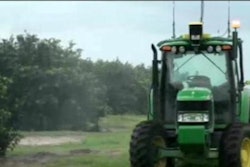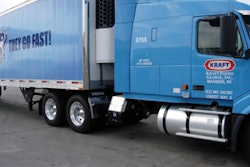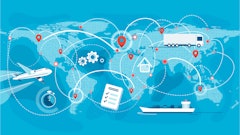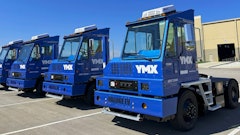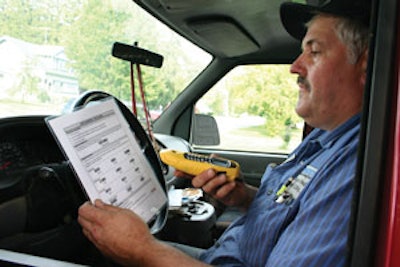
On-board global positioning satellite (GPS) systems can be very expensive to install in a delivery vehicle. Some industry experts estimate the cost at $1,000 per truck.
Multiply that by five-to-10 times or more for larger fleets and it becomes apparent why food companies are equipping their drivers with GPS-enabled cell phones.
These cell phones, sold by companies such as AT&T and Sprint, can cost as little as $30 per handset. Using this breed of cell phone is becoming an easy, economical inroad for many companies to avail themselves of basic GPS services as well as the software tools associated with them.
"There are two basic requirements for these cell phones," says Andrew Roszko, vice president of on demand solutions for Descartes Systems Group, Toronto, Canada. "First, we have to install an application that sits on the cell phone, which means it has to have enough memory to support that application. Second, you need a GPS chip."
These phones are recording a GPS point from a satellite and storing it. The software is telling it, at predetermined intervals, to transmit these GPS points.
"If you didn't have the phone technology, you could still record the data, but you wouldn't be able to transmit it somewhere so everyone can see it in real-time," says James Stevenson, vice president of Oklahoma City-based Appian Logistics.
"Once the cell phone captures that information from the satellite-and this is true for the truck- mounted as well as the handheld versions-it sends that over the cellular network to systems that are hosted by third parties," explains Laura Johnson, executive director of enterprise solutions for AT&T Wireless, Parsippany, NY.
The web sites these companies maintain contain software that pulls the data from cell phones, in addition to providing corresponding driver location maps. Dispatchers from distribution companies can then log on through their browser to the hosted web site, in order to get all the real-time GPS information they require.
For many smaller companies, employing a hosted solution, rather than maintaining their own server and IT department, can be a cost-effective, low-risk way to get up-and- running.
"In terms of installing a server and software, we take that burden off our customers," says Descartes' Roszko. "They just go to the web and see the application. That's the advantage of going with a software-as-a-service type model. We give them the ability to go on a month-to-month subscription for this service to use over the internet."
Monitoring Drivers And Trucks
The biggest use of GPS cell phones is to track drivers and their vehicles.
"Drivers don't necessarily tell the truth about where they are," explains Appian's Stevenson. "GPS is the audit to let companies know their exact positioning at any point during the day-you can see where the driver punched in and where the GPS system says he is. They should match up."
"One customer we work with," says AT&T's Johnson, "has drivers who refill vending machines and collect money from them. They also need to track where the driver goes, which these phones allow. If you have two buildings next to each other and the driver was routed to go into building 'A' and you see that he goes into building 'B' instead, this is a way to catch potential fraud."
Keeping track of where vehicles are is an important thing from a liability standpoint, especially for companies that are running large truck fleets.
"If there's an accident," says Butch Musselman, vice president of enterprise solutions for Sprint, Reston, VA, "they can go back and pulls the diagnostics off the vehicle and determine whether or not the vehicle was speeding."
He points to an example involving a large customer that was being sued by a woman who said one of their trucks had side-swiped her car. The company went back to the GPS records and confirmed none of their vehicles were ever near the woman's location. It won the case in court.
Optimizing Routes
Today, companies are integrating software into the back-end of the GPS equation that is allowing shippers to take the tracking information provided to them and then use it to improve their routing and scheduling in order to get more control over their routes. The days of manual route optimization are over.
When a driver stops his vehicle for a predetermined amount of time, the system will compare where he is to the list of planned stops and if it's within 1,000 feet, it will assume the stop is the actual one that the company gave him. The system will then update his actual arrival. It will also provide an update when he departs. These systems are also using GPS data to actually re-forecast the ETAs on all the remaining stops.
"You want to know if there is going to be a customer service violation somewhere in the route," says Appian's Stevenson. "Most of these customers are fairly strict about when you can make deliveries-you just can't show up at any time."
The system can be set up to automatically flag a dispatcher if there will be a time-window violation and he can then notify the next customer when they should expect their delivery. The system also allows dispatchers to add stops or remove stops. This new information will show up on the driver's phone, making it a completely interactive two-way communication between the driver and the office.
GPS-enabled cell phones are also improving the accuracy of routes themselves.
"A route is only as good as its execution," says Cindi Brandt, Marketing Manager for UPS Logistics Technology in Baltimore. "GPS systems allow you to clock service time. If it always takes 25 minutes to service 'Cindi's Diner,' you need to know that because then you can create your plan with more accuracy."
UPS' Roadnet Transportation Suite software allows routers to select the "least scored" average delivery time to a particular location, throwing out the higher and lower rates, in order to forecast more accurate services times to that location.
"Typically," says Descartes' Roszko, "planners are building their routes on a series of estimates. If you think the driver can do 12 stops in eight hours and then you get the information back and you see he did 12 stops in six hours, you know you can add more stops on that route."
Another routing issue that the new technology addresses is the "returns" problem. Typically, if a driver shows up outside of a time window and the receiving department is closed, he'll have to come back another day, which means additional costs are incurred. The system allows companies to stay ahead of such problems.
"If your driver was delayed at the first costumer for 45 minutes, which means that downstream he's going to be late on customer number eight, you'll see an alert on the screen that says you should reschedule the driver and have him go there earlier, or call the customer and see if it's okay that you're 15 minutes late," explains Roszko.
He notes that if a company can bring its return percentages down, it can save a great deal of money, perhaps hundreds of dollars a day, on its bottom line.
"To put the numbers in perspective, when we go from routing manually to routing with a piece of software, we see 10 to 15 percent mileage savings."
Making Exceptions
With GPS tracking "you'll definitely see a productivity bump," says Jason Koch, president of OnTrack, the GPS fleet management solution for Irvine, CA-based Telogis. "It's the standard 'I know that someone is watching me' thing, what I refer to as the 'GPS Effect.' If you just track them, what's going to happen is you'll see an initial productivity bump. Over a couple of months, that productivity bumps is going to wane once they realize that you're not really looking at it on a daily basis."
In order to avoid "watching the dots," Koch says companies need to utilize fleet management solutions like OnTrack to turn their systems into exception-based ones, rather than a system that requires constant monitoring. Dispatchers can instruct system software to send them exception reports if a driver deviates from their route.
Deviations might include unplanned stops, early arrivals, late departures, service time violations, running routes out of sequence, going outside of geo fences, speeding violations, even violation of Department of Transportation Hours of Service rules.
"When an exception happens it alerts the company in real-time," says Koch. "It can even send an email to the customer telling them you're going to be late."
These systems also allow drivers to explain route deviations, thanks to the interactive menus on their cell phones.
"We allow them to type in Over, Short and Damage information," notes UPS' Brandt. "Such as: 'I planned to deliver six cases, I only delivered five.' That's great for order-to-cash type information."
Productivity Improvements
When all is said and done, the biggest incentive for implementing any new system is always productivity-how will it help you move more product? With GPS-enabled cell phones it is no different.
"In conjunction with Roadshow, we've implanted a system called MobileLink Status," notes Tom Wydra, corporate fleet manager for Edward Don and Co., a North Riverside, IL company that delivers restaurant supplies to eateries and schools. "The driver's manifest is downloaded right to the phone and from that he proceeds from one stop to another. In the phone itself he'll hit a key that says when he's arrived at a stop, as well as when he's completed a stop."
Wydra runs a performance summary report at the end of the day that compares performance times they have in the system-from when they originally routed the driver's route performance time-to show how he's actually running the route now. This gives them insight into how productive the driver is currently being.
"We can see where he's losing time and we'll send a supervisor out with him if we're having a serious time problem."



